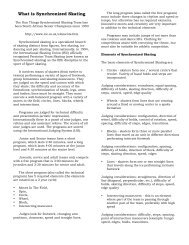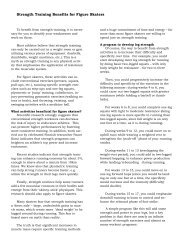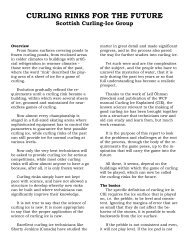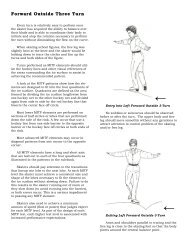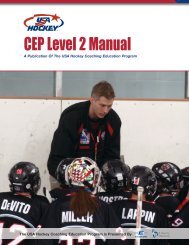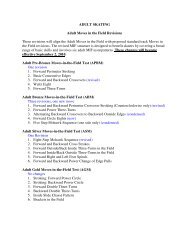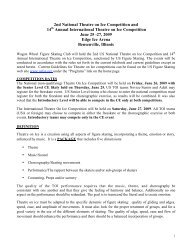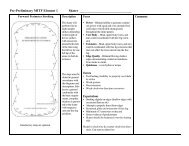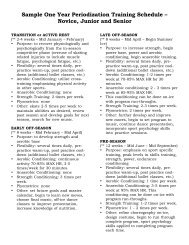CEP Level 3 Manual - Rushmore Hockey Association
CEP Level 3 Manual - Rushmore Hockey Association
CEP Level 3 Manual - Rushmore Hockey Association
You also want an ePaper? Increase the reach of your titles
YUMPU automatically turns print PDFs into web optimized ePapers that Google loves.
T A B L E O F C O N T E N T SDefensive and Offensive Gap ControlGap control applies to all players on the ice(offensive and defensive) from one-on-onesituations to five-on-five situations. In the past thetalk of gap control - closing the gap, etc. has focusedtoo much on the defensive segments of the game,when in reality its influence is equally as importantin the offensive segment of hockey.Objectives• Control of situation offensively anddefensively• Influence play offensively and defensively• Reduce time-space-force of an attack• Create time-space-force of an attack• Regain puck possession• Retain puck possession• Prevent scoring opportunities• Gain scoring opportunitiesFar too often as coaches we become enamoredwith the overall look of a tactic, overlooking the keyskills necessary to execute it. These skills (physicaland mental) must not be neglected and must benurtured at every practice. No player is too old,experienced or skilled to be excluded from thecontinual development of individual skills which area vital component of an effective athlete.Additionally, these skills mastered by the athlete willcreate confidence reflecting in the athlete’s overallperformance.Key Components1. Skating• speed• quickness• agility• balance• transition• acceleration2. Proper checking techniques3. Play away from the puck4. One-on-one confrontation technique5. Decision making: when? where? how?6. Proper mental attitudeCoach’s Question:A. Are you one of those coaches who questionthe contribution of certain players becausethey can’t execute within the system?B. Are you a coach who knows the value ofcontinually providing time to develop theskills of your players throughout the seasonso they may meet the skill necessary toachieve total peak performance within asystem?Small Game Activities/DrillsOne of the coach’s major responsibilities is tocreate an environment so the athlete has theopportunity to reach his/her optimum level of peakperformance.In developing the athlete’s decision-makingskills, the coach needs to put the athlete in as manygame situations as possible allowing the athlete anopportunity to come up with solutions.The coach must make the athlete realize thatthere is more than one solution to any givensituation and that the decision made will be basedon many factors such as ability, confidence,knowledge, game situation, etc.An excellent way to develop decision-makingskills in a hockey player are small area/gameactivities which will create an environmentchallenging players. Players gain a betterunderstanding of pressure, stall/contain, support,transition, and time/space.Mental AttitudeEnergy will be used in this presentation todescribe a hockey player’s degree of mentalattitude. Athletes who are somewhat energized willgenerally perform better and reflect confidence intheir overall performance. Peak performancecomes when the player has reached his/heroptimum level of energy.Listed below are a few energizing techniques forcontrolling and increasing a player’s mental energylevel.• Positive self-talk• Positive mental imagery• Psych-up technique• Goal setting• Relaxation technique• Deep breathing technique• Task focus techniqueDefensively• Reducing time/space/force of an attack• Limit the speed and velocity of play• Prevent penetration to the prime scoringareas• Isolate game situations and avoid gettingoutnumbered• Control• Be pro-activeOffensively• Creating time/space/force for your attack• Control the speed and velocity of the play• Penetrate the prime scoring areas• Create outnumbering situations andmaximize opportunities• Control• Be pro-activeBasic Concepts for Sound Gap Control• Communication both verbally and visually• Protect or attack critical areas of the ice• Create or eliminate offensive and defensiveoptions• Defensive or offensive side positioning.• Angling - steering - deflecting• Control the speed of the attack orcreating/controlling multiple speeds for theattack• Stick on stick - body on body principle• Effective use of body-stick-boards-and areasof the iceTight GapPressureAngleLoose GapContainDirect PenetrationFactors in Decision MakingThere are many factors influencing the read on aparticular situation and in making a decision for gapcontrol. Creating opportun-ities and an environmentfor your players to experiment and master theseskills is your challenge as a coach. Below are a fewhelpful hints and cues which will assist them in theirprocess:• Defensively look through/beyond the attack• Offensively look beyond/through your attack• Know what support you have offensively ordefensively• Who is controlling the puck and what type ofcontrol do they have?• Where is the situation in relationship to theice surface (ice position): close to theboards; in open ice; what zone; defensiveblue line; offensive blue line; prime scoringarea?• Speed and direction of the play• Total game awareness; score; period; type ofgame; specialty teams; etc.Should you take an aggressive attitudeoffensively or defensively regarding your approachto gap control? Based on what system you play,there must be a philosophy or “attitude” establishedfor this component of the game.Tight Gap Control Defensive Reads1. Approaching the backside of a puck carrier2. When a puck carrier moves across the ice oralong your defensive blue line3. The skating speed of both players and thesituation is the same4. The offensive player has not established solidcontrol of the puck5. When you numerically outnumber theoffensive opponent6. When you have isolated the situation downto one-on-one7. When the puck carrier is attempting topenetrate the prime scoring/grade A area8. The puck carrier is in a “threat” to scoreposition254 | USA <strong>Hockey</strong> Coaching Education Program <strong>Level</strong> 3 <strong>Manual</strong>Defensive Team Tactics | 255



